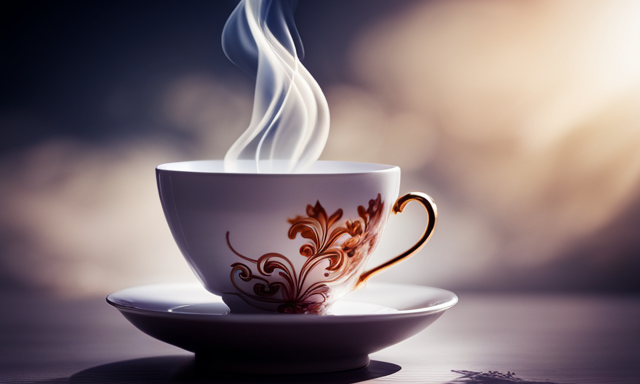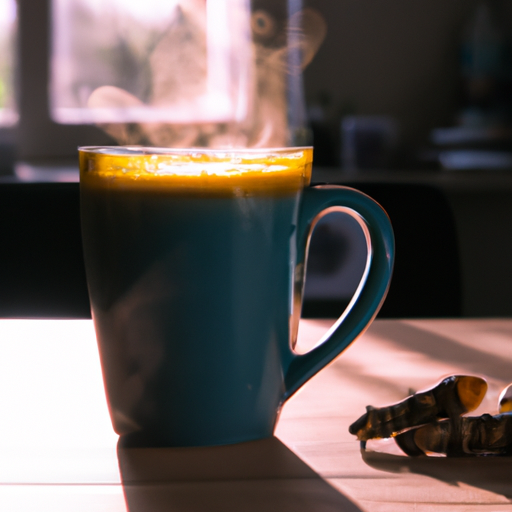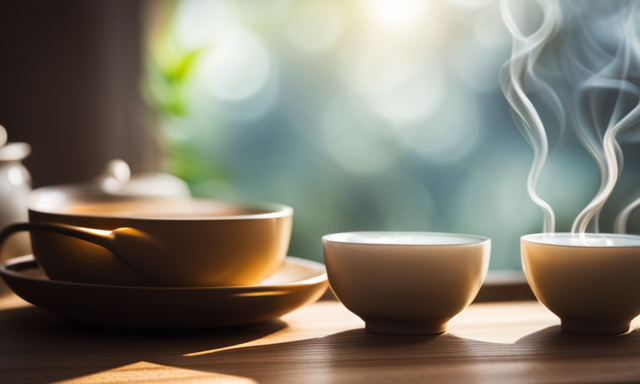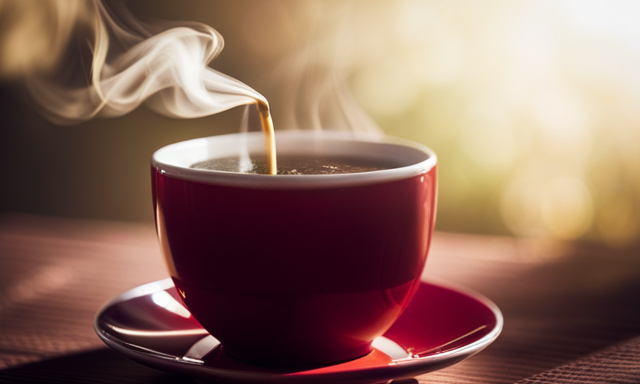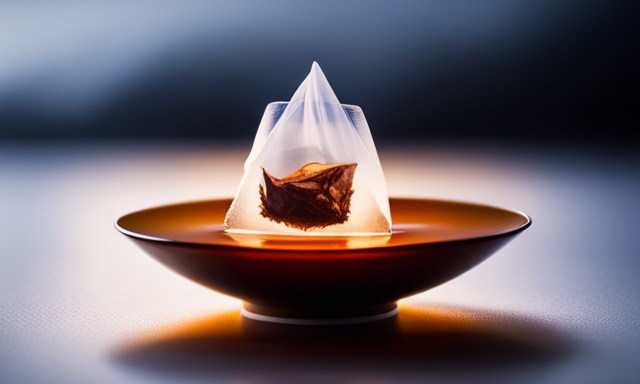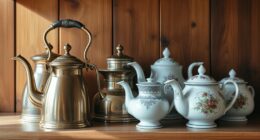Step into the fascinating world of oolong tea, where every sip is a journey of flavor and tradition. As a tea enthusiast, I am thrilled to share with you the wonders of this unique and versatile beverage.
Oolong tea, with its rich history and distinct taste, has captured the hearts of tea lovers around the globe.
Originating from China, oolong tea is crafted through a meticulous oxidation process that brings out its characteristic flavors and aromas. From the delicate and floral to the robust and earthy, each variety of oolong tea offers a sensory experience like no other.
But it doesn’t stop there – oolong tea is also known for its numerous health benefits, from boosting metabolism to promoting weight loss.
Join me on this exploration of oolong tea, as we delve into its cultural significance, culinary applications, and where to find the finest blends. Let’s embark on this tea adventure together and discover the world of oolong tea.
Key Takeaways
- Oolong tea has a rich history and cultural significance in Chinese society, being served during important events and ceremonies.
- The oxidation process is crucial in creating the distinct flavor profiles of different oolong tea varieties, with timing playing a key role in achieving the desired level of oxidation.
- Oolong tea offers various health benefits, such as boosting metabolism, promoting weight loss, enhancing mental clarity, supporting digestive health, and strengthening the immune system.
- Brewing techniques, including temperature and steeping time, can be adjusted to enhance specific flavors and achieve the perfect cup of oolong tea.
Origins and History of Oolong Tea
The origins and history of oolong tea are truly fascinating. Oolong tea has its roots in China, where it has been cultivated for centuries. The exact origins of oolong tea are unknown, but it is believed to have originated in the Fujian province during the Ming dynasty.
The cultivation techniques used for oolong tea are highly specialized, with growers carefully tending to the plants to ensure the best quality leaves. Oolong tea holds significant cultural significance in Chinese society, often being served during important events and ceremonies. There are also specific rituals associated with the preparation and serving of oolong tea, adding to its allure.
Now, let’s delve into the oxidation process: how oolong tea is made.
The Oxidation Process: How Oolong Tea is Made
During the oxidation process, the leaves undergo a transformation that brings out a rich and complex flavor profile. Oolong tea production methods play a crucial role in achieving the desired flavor and aroma.
The level of oxidation determines the final characteristics of the tea. Once the leaves are plucked, they are carefully withered to reduce their moisture content. Then, the oxidation process begins by gently bruising the leaves, allowing them to react with the air.
The leaves are then spread out to oxidize further, and the timing is crucial to achieve the desired level of oxidation. This step is closely monitored to ensure that the leaves do not become too oxidized or under-oxidized.
The oxidation process contributes to the development of the unique flavor and aroma of oolong tea. It is this balance between oxidation and other factors that creates the distinct flavor profiles of different oolong tea varieties.
Distinct Flavor Profiles of Different Oolong Tea Varieties
Indulge your taste buds with the diverse and captivating flavor symphonies found in various oolong tea varieties. Each type of oolong tea offers a unique flavor profile that is a delight to explore.
From the floral and fruity notes of Tie Guan Yin to the rich and nutty taste of Da Hong Pao, there is an oolong tea to suit every palate.
The brewing techniques also play a crucial role in bringing out the distinct flavors of each variety. The temperature and steeping time can be adjusted to enhance specific flavors, allowing you to customize your tea experience.
As we delve into the health benefits of oolong tea, it’s fascinating to see how these flavors contribute to the overall well-being. So, let’s take the next sip and discover the incredible benefits that oolong tea has to offer.
Health Benefits of Oolong Tea
Get ready to savor the goodness of oolong tea as we explore its numerous health benefits. Oolong tea is not only a delightful beverage but also a powerhouse of health benefits. Here are four reasons why you should incorporate oolong tea into your daily routine:
-
Boosts Metabolism: Oolong tea contains polyphenols and caffeine that can increase metabolism and help burn calories more efficiently.
-
Enhances Mental Clarity: The combination of caffeine and L-theanine in oolong tea promotes alertness and improves focus, providing mental clarity throughout the day.
-
Supports Digestive Health: The antioxidants in oolong tea aid in digestion, reducing bloating and improving overall gut health.
-
Strengthens Immune System: Oolong tea is packed with antioxidants that can help strengthen the immune system and protect against common illnesses.
With its ability to boost metabolism and promote weight loss, oolong tea is a fantastic addition to any healthy lifestyle. Now, let’s dive into how it achieves these incredible benefits.
Boosts Metabolism and Promotes Weight Loss
Oolong tea is not only a delicious beverage, but it is also one of the best metabolism boosting foods out there. Research has shown that oolong tea can increase metabolism and promote weight loss by increasing fat oxidation and enhancing energy expenditure. It contains polyphenols, which activate enzymes that help break down fat cells and improve fat metabolism.
Additionally, oolong tea can help curb cravings and promote feelings of fullness, making it a great addition to any weight loss journey. So, if you’re looking for a natural and effective way to shed those extra pounds, incorporating oolong tea into your diet is definitely worth considering. It’s time to take your weight loss goals to the next level with this incredible tea.
And guess what? Oolong tea doesn’t just stop at boosting metabolism and promoting weight loss—it also improves heart health.
Improves Heart Health
Improving heart health is crucial for a longer, healthier life, and incorporating this remarkable beverage into your daily routine can make a significant difference. Oolong tea, with its rich antioxidants and polyphenols, has been shown to improve heart health in several ways:
-
Reduces cholesterol levels: Oolong tea helps lower LDL (bad) cholesterol levels, which can reduce the risk of heart disease.
-
Lowers blood pressure: Regular consumption of oolong tea has been linked to lower blood pressure levels, promoting a healthy cardiovascular system.
-
Enhances blood vessel function: The antioxidants in oolong tea can improve blood vessel function, reducing the risk of blood clots and improving overall heart health.
In addition to its heart-healthy benefits, oolong tea also enhances mental alertness and focus. It contains caffeine and L-theanine, which work together to stimulate the brain and improve cognitive function. Transitioning into the next section, oolong tea not only improves heart health but also enhances mental alertness and focus.
Enhances Mental Alertness and Focus
Boost your mental alertness and focus with this incredible beverage that will have you feeling sharper and more productive throughout the day, even if you’re concerned about caffeine intake.
Oolong tea not only provides a gentle boost of energy, but it also improves cognitive function and increases productivity. The combination of caffeine and theanine, an amino acid found in oolong tea, works together to enhance mental clarity and concentration.
The caffeine stimulates the central nervous system, while the theanine promotes a state of calm alertness, preventing the jittery feeling often associated with coffee. Studies have shown that oolong tea can improve memory, attention, and overall brain function.
So, if you’re looking for a natural way to stay focused and improve your mental performance, oolong tea is the perfect choice.
Transitioning to the next section, oolong tea also supports digestive health by aiding in digestion and promoting a healthy gut.
Supports Digestive Health
Aiding in digestion and promoting a healthy gut, this remarkable beverage is a soothing elixir for your digestive health. Oolong tea not only boosts energy but also aids in digestion, making it a perfect choice after a heavy meal. Its unique combination of catechins, antioxidants, and polyphenols helps to alleviate digestive issues such as bloating, indigestion, and constipation. Oolong tea stimulates the production of digestive enzymes, which enhances the breakdown of food and the absorption of nutrients. It also acts as a natural diuretic, flushing out toxins from the body and reducing water retention.
To give you a visual representation of the benefits of oolong tea for digestive health, here is a table showcasing its key properties:
| Benefits | Description |
|---|---|
| Boosts Energy | Provides a natural energy boost to combat fatigue |
| Aids in Digestion | Promotes healthy digestion and relieves digestive issues |
| Rich in Antioxidants | Fights free radicals and protects against cell damage |
| Supports Weight Loss | Helps to regulate metabolism and burn fat |
With its ability to support digestive health, oolong tea sets the stage for the subsequent section about how it strengthens the immune system.
Strengthens the Immune System
Feeling under the weather? Sip on a cup of this magical elixir and watch as it fortifies your immune system, giving it the strength of a superhero!
Oolong tea is packed with antioxidants and nutrients that boost immunity and strengthen defenses. Here are some reasons why you should make oolong tea your go-to beverage when you’re feeling a bit run down:
-
The polyphenols in oolong tea help fight off harmful bacteria and viruses, reducing the risk of infections.
-
Oolong tea contains catechins, which have been shown to have anti-inflammatory properties, supporting a healthy immune response.
-
The high levels of vitamin C in oolong tea stimulate the production of white blood cells, which are essential for a strong immune system.
-
Oolong tea also contains minerals like manganese and potassium, which play a crucial role in maintaining a healthy immune system.
So, why wait? Start brewing a cup of oolong tea and give your immune system the boost it needs.
Moving on to brewing techniques: tips for the perfect cup of oolong tea…
Brewing Techniques: Tips for the Perfect Cup of Oolong Tea
After learning about the immune-boosting benefits of oolong tea, let’s now delve into the art of brewing the perfect cup.
To achieve the optimal flavor and aroma, it’s essential to pay attention to two critical factors: brewing temperature and steeping time. Oolong tea leaves are delicate and require careful handling.
The ideal brewing temperature for oolong tea is usually between 180-200°F (82-93°C). Steeping time varies depending on personal preference and the specific oolong tea variety, but it typically ranges from 2 to 5 minutes. Longer steeping times result in a stronger and bolder flavor, while shorter times yield a milder taste.
Now that we have mastered the brewing techniques, let’s explore the world of oolong tea even further by discovering the popular oolong tea varieties and their unique characteristics.
Popular Oolong Tea Varieties and Their Characteristics
To fully appreciate the world of oolong tea, you’ll want to explore the popular varieties and their unique characteristics. Here is a table that showcases some of the most well-known oolong tea varieties and their defining traits:
| Variety | Characteristics |
|---|---|
| Tie Guan Yin | Floral aroma, smooth and mellow flavor |
| Da Hong Pao | Robust and rich with hints of roasted nuts and chocolate |
| Oriental Beauty | Sweet and fruity taste with a honey-like aroma |
| Jin Xuan (Milk) | Creamy and milky flavor, reminiscent of milk or butter |
| Wuyi Rock | Strong and earthy taste, with a lingering mineral note |
Each of these oolong teas has its own unique profile, offering a diverse range of flavors and aromas. Exploring these varieties will not only enhance your oolong tea experience but also provide insight into the intricacies of oolong tea brewing techniques and the potential health benefits it can provide. Now, let’s delve into the fascinating world of Tie Guan Yin (Iron Goddess).
Tie Guan Yin (Iron Goddess)
Moving on from the popular Oolong tea varieties, let’s delve into the fascinating world of Tie Guan Yin, also known as Iron Goddess. This tea is highly revered for its unique characteristics and health benefits.
Tie Guan Yin is cultivated in the Fujian province of China, where the climate and soil conditions create the perfect environment for its growth. The tea leaves are carefully hand-picked and processed to bring out their distinctive flavors and aromas.
When consumed, Tie Guan Yin offers a multitude of health benefits. It is known to aid in digestion, boost metabolism, and promote weight loss. This tea is also rich in antioxidants, which help to fight free radicals in the body and support overall well-being.
Now, let’s transition to our next subtopic, Da Hong Pao (Big Red Robe), another renowned Oolong tea variety.
Da Hong Pao (Big Red Robe)
Renowned for its rich history and revered as the king of all Oolong varieties, Da Hong Pao leaves tea enthusiasts captivated with its complex flavors and lingering aroma. Da Hong Pao, also known as Big Red Robe, is a highly prized tea from the Wuyi Mountains in China. Its history dates back to the Ming Dynasty, where it was said to have been enjoyed by the emperor himself. This prestigious tea is made from the leaves of ancient tea trees and is known for its bold, roasted taste with hints of caramel and chocolate. Its flavor profile is robust, yet smooth, and it leaves a pleasant, long-lasting aftertaste. The unique combination of the terroir and the meticulous processing methods contribute to the exquisite taste of this legendary tea. Now, let’s dive into the intriguing world of Bai Hao Oolong (Oriental Beauty).
Bai Hao Oolong (Oriental Beauty)
After exploring the rich history of Da Hong Pao, let’s delve into another fascinating type of oolong tea: Bai Hao Oolong, also known as Oriental Beauty. This unique tea is renowned for its exquisite flavor and aroma, making it a favorite among tea connoisseurs.
The tea making process of Bai Hao Oolong is meticulous and requires skilled hands. The leaves are carefully plucked from tea bushes that are infested by a specific type of small green leafhopper. These insects bite the leaves, causing them to release unique enzymes that contribute to the tea’s distinct flavor profile.
After plucking, the leaves are oxidized to a specific level, which results in a complex combination of fruity, floral, and honey-like notes.
Now, let’s move on to explore another delightful variant of oolong tea: Jin Xuan, also known as milk oolong.
Jin Xuan (Milk Oolong)
Jin Xuan, also known as milk oolong, is a velvety smooth and creamy delight that will transport your taste buds to a tranquil dairy farm. This unique oolong tea gets its distinct flavor profile from the Jin Xuan cultivar, which is grown in the high mountain regions of Taiwan. The leaves of this tea are hand-picked and carefully processed to bring out the natural milky and buttery notes.
To fully appreciate the flavors of milk oolong, it is important to use the right brewing techniques. The water temperature should be around 185°F (85°C) and the leaves should steep for about 3-4 minutes. This will allow the tea to develop its rich and creamy taste, reminiscent of sweet milk and orchids.
Transitioning to the next section, let’s explore the unique characteristics of dong ding (frozen summit) oolong tea.
Dong Ding (Frozen Summit)
Moving on from the delightful Jin Xuan (Milk Oolong), let’s now delve into the realm of Dong Ding (Frozen Summit) oolong tea. This particular tea, named after the mountain where it is grown in Taiwan, offers a fascinating production process and unique characteristics.
To create Dong Ding tea, the leaves are hand-picked and gently withered. They are then tossed in large bamboo baskets to bruise the edges, initiating oxidation. The leaves are then gently roasted multiple times to develop their complex flavors.
When brewed, Dong Ding oolong tea showcases a rich and smooth flavor profile with floral and fruity undertones. It often carries the aroma of ripe peaches and offers a sweet, honey-like finish.
With its distinctive production process and captivating flavor notes, Dong Ding oolong tea is a true gem.
Now, let’s further explore the wonders of oolong tea and its deep-rooted connections to traditional Chinese tea culture.
Oolong Tea and Traditional Chinese Tea Culture
Discover the rich tapestry of traditional Chinese tea culture and immerse yourself in the ancient rituals and customs that have shaped the world of this beloved beverage.
Oolong tea holds a significant place within this cultural landscape, showcasing the artistry and expertise of Chinese tea masters. Its cultural significance is reflected in the intricate processing methods, which involve withering, oxidation, and unique roasting techniques.
Oolong tea is not only enjoyed for its exquisite taste but also for its positive impact on the environment. The tea leaves are grown in mountainous regions, where the natural ecosystem is preserved and protected. This sustainable approach ensures the longevity of both the tea plants and the surrounding environment.
As oolong tea gains popularity worldwide, its cultural heritage and environmental benefits continue to captivate tea enthusiasts across the globe.
The Growing Popularity of Oolong Tea Worldwide
With its delicate flavors and health benefits, oolong tea has swiftly become a global sensation, spreading like wildfire across continents. Its growing popularity can be attributed to several factors:
-
Health benefits: Oolong tea is rich in antioxidants, which help boost the immune system and reduce the risk of chronic diseases. It also aids in weight management and promotes healthy skin.
-
Different brewing techniques: Oolong tea offers a wide range of flavors depending on the brewing technique used. From a light and floral taste to a rich and robust flavor, there is a brewing method to suit every palate.
-
Cultural appreciation: As more people become interested in traditional Chinese tea culture, oolong tea has gained recognition for its significance and history.
-
Versatility: Oolong tea is not only enjoyed as a beverage, but it is also a versatile ingredient in culinary applications, adding unique flavors to dishes and desserts.
As oolong tea continues to captivate tea lovers worldwide, its versatility as a culinary ingredient will be explored in the subsequent section.
Oolong Tea: A Versatile Ingredient in Culinary Applications
As we’ve seen, the popularity of oolong tea has been steadily growing worldwide. But did you know that oolong tea is not just a beverage, but also a versatile ingredient in culinary applications?
Its unique flavor profile and aroma make it a favorite among chefs and food enthusiasts alike. Oolong tea can be used in a variety of dishes, from savory marinades to sweet desserts. Its floral, fruity, and sometimes nutty notes add depth and complexity to any recipe.
The culinary creativity that comes with using oolong tea knows no bounds, as it can be paired with a wide range of ingredients to create unique flavor combinations.
So, whether you’re a professional chef or a home cook looking to elevate your dishes, consider incorporating oolong tea into your culinary repertoire.
Now, let’s explore where to find and buy high-quality oolong tea.
Where to Find and Buy High-Quality Oolong Tea
Looking to elevate your culinary creations? Find and buy the finest oolong tea from reputable tea shops and online vendors.
When it comes to where to buy oolong tea online, there are several options to consider. One of the best oolong tea brands is Teavana, known for their high-quality loose leaf teas. They offer a wide variety of oolong teas, ranging from light and floral to rich and toasty.
Another great option is Mountain Rose Herbs, an online retailer that specializes in organic and sustainably sourced teas. They have a selection of premium oolong teas that are sure to impress even the most discerning tea connoisseurs.
Whether you prefer the convenience of online shopping or the personal touch of a local tea shop, these options will ensure you find the perfect oolong tea for your culinary needs.
Frequently Asked Questions
How does the oxidation process affect the flavor of oolong tea?
The oxidation process in oolong tea is like a delicate dance, transforming its flavor profile. As the tea leaves undergo oxidation, their natural flavors deepen and develop, resulting in a complex and nuanced taste that is unique to oolong tea.
Can oolong tea be beneficial for individuals with digestive issues?
Oolong tea can be beneficial for individuals with digestive issues. It helps improve digestion, reduce inflammation, and provide relief from symptoms like bloating and indigestion. Its effectiveness lies in its natural compounds that promote a healthy digestive system.
Are there any specific brewing techniques that are recommended for oolong tea?
To bring out the best flavor profiles of oolong tea, specific brewing techniques are recommended. For example, using water at around 190-200°F and steeping for 3-5 minutes can enhance its rich, floral, and slightly fruity taste.
What is the significance of Tie Guan Yin and Da Hong Pao oolong tea varieties?
The significance of tie guan yin and da hong pao oolong tea varieties lies in their rich history and unique flavors. They are highly prized in traditional Chinese tea ceremonies and offer numerous health benefits for digestion. The oxidation process gives oolong tea its distinct flavor profile.
Is oolong tea commonly used in traditional Chinese tea ceremonies?
Yes, oolong tea is commonly used in traditional Chinese tea ceremonies. Its cultural significance lies in its historical connection to Chinese tea culture and its reputation as a high-quality and flavorful tea variety.
Conclusion
Oolong tea is a type of tea that falls between green tea and black tea in terms of oxidation. It is known for its unique and complex flavors, which can range from floral and fruity to toasty and earthy. The leaves of oolong tea are partially oxidized, giving them a distinct appearance and taste. This oxidation process is what sets oolong tea apart from other types of tea.
Oolong tea has a long history in Chinese culture and is often associated with traditional tea ceremonies. It is believed to have originated in the Fujian province of China, where it is still produced today. The production of oolong tea involves withering the leaves under the sun, then gently bruising them to start the oxidation process. The leaves are then rolled and shaped before being dried. This careful process allows the flavors and aromas of the tea to develop fully.
One of the key characteristics of oolong tea is its ability to offer a wide range of flavors and aromas. This is due to the varying degrees of oxidation that different varieties of oolong tea undergo. Lightly oxidized oolongs tend to have a more delicate and floral flavor profile, while heavily oxidized oolongs can have a richer and more robust taste. Some oolong teas may even exhibit a natural sweetness or a lingering aftertaste.
In addition to its enticing flavors, oolong tea is also known for its potential health benefits. It contains antioxidants that can help protect the body against free radicals and reduce the risk of chronic diseases. Oolong tea has also been associated with boosting metabolism and aiding in weight loss. It may also have a positive impact on heart health and digestion.
Overall, oolong tea offers a tantalizing experience for tea enthusiasts. Its unique flavors, rich history, and potential health benefits make it a popular choice among tea drinkers. Whether you prefer a light and delicate oolong or a bold and robust one, exploring the world of oolong tea is sure to be a tantalizing adventure. So why not indulge in a cup of oolong tea and savor its tantalizing allure for yourself?

